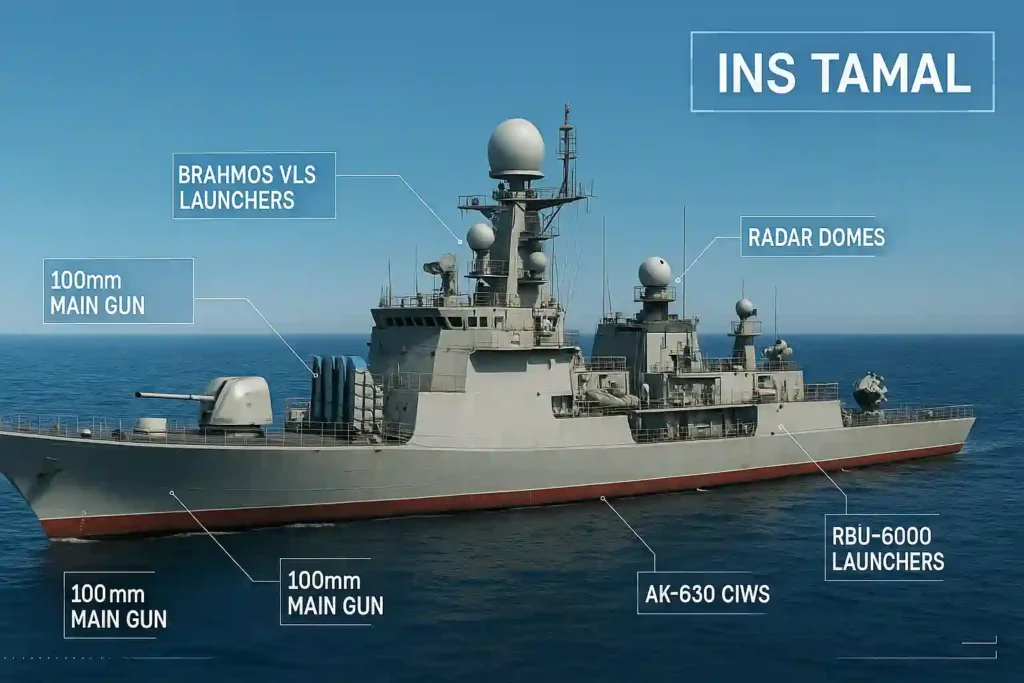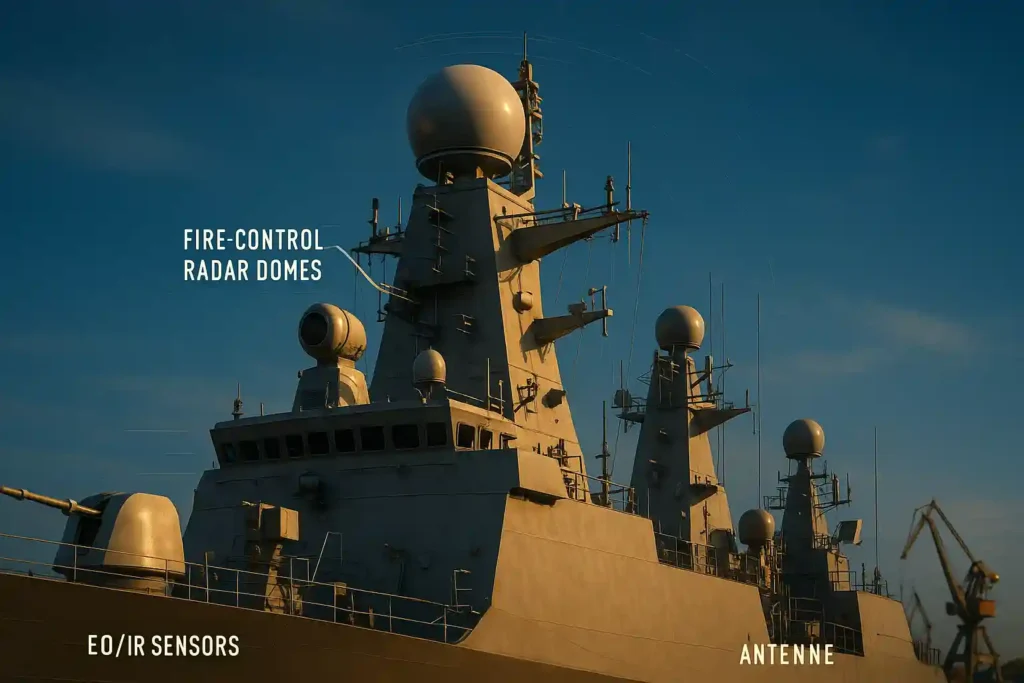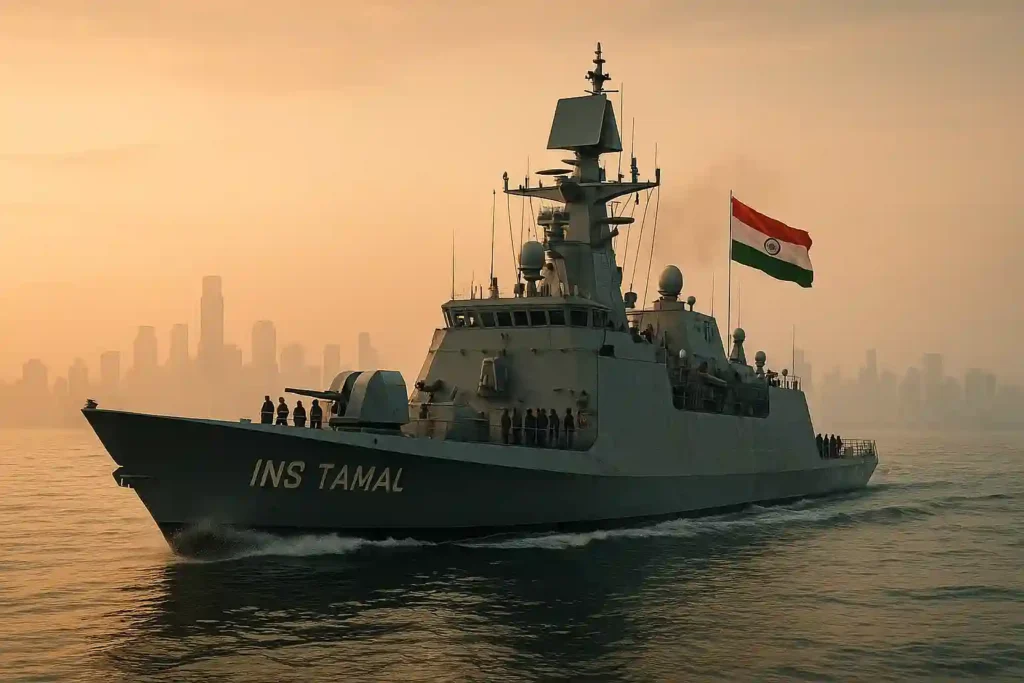India’s naval power is undergoing a remarkable transformation, and at the centre of this shift is the INS Tamal, a cutting-edge stealth warship that blends advanced maritime technology, firepower, and indigenous innovation. Commissioning on 1 July 2025, this frontline frigate isn’t just another addition to the fleet—it’s a historic moment. It represents the last foreign-built warship to be inducted into the Indian Navy, aligning perfectly with the country’s push for Aatmanirbhar Bharat in defence manufacturing.
In this article, you’ll discover everything about the INS Tamal warship—from detailed specifications and combat systems to its role in India’s maritime strategy. If you’re looking for the most comprehensive and recent breakdown of India’s newest stealth frigate, you’re in the right place.
What is INS Tamal?
INS Tamal is India’s latest guided-missile stealth frigate, classified under the upgraded Tushil-class (Project 11356.6). Built by Russia’s Yantar Shipyard in Kaliningrad, it follows the proven Talwar-class and Teg-class frigates, incorporating advanced combat systems and a higher degree of modular sensor and weapons integration.
But more than its technical prowess, the ship marks a turning point in Indian naval procurement. With the commissioning of the INS Tamal frigate, the Indian Navy formally ends its reliance on foreign-built warships, stepping into a new chapter of indigenous design and manufacturing.
The Origin: How INS Tamal Came to Life

A Decade in Development
INS Tamal’s story began in November 2013, when the keel was laid under the name Admiral Istomin. The project saw multiple geopolitical hurdles, including delays due to sanctions and component availability. However, by mid-2025, the ship emerged sea-ready, armed, tested, and ready for deployment.
Official Commissioning Ceremony
INS Tamal will be formally commissioned on 1 July 2025 in Kaliningrad, Russia, by Vice Admiral Sanjay J Singh, the Flag Officer Commanding-in-Chief of the Western Naval Command. The event will mark the end of India’s Krivak-class acquisition programme, under which eight advanced stealth frigates were imported over two decades.
Why INS Tamal Is a Strategic Game-Changer
The Last of Its Kind
This warship is more than just a symbol—it’s a capability enhancer:
- Final Russian-built warship for India, signalling a shift to 100% indigenous warship manufacturing.
- Will serve in the Western Naval Command, enhancing India’s blue-water naval operations in the Indian Ocean Region (IOR).
- Integrates high-end maritime combat systems, blending Russian legacy with Indian upgrades.
Additionally, the vessel brings in next-gen naval combat integration that will now become standard across future projects like Project 17A frigates and Project 18 destroyers.
INS Tamal Specifications and Endurance Profile

A Stealth Frigate Built for Versatility
The INS Tamal is designed for high-seas patrols, anti-surface warfare, anti-aircraft defence, and submarine hunting operations. With a displacement of 3,900 tonnes, length of 125 metres, and top speeds exceeding 30 knots, the ship is built for speed, stealth, and survivability.
Its dual gas turbine propulsion delivers over 44,000 horsepower, allowing it to operate across extended missions—ideal for strategic sea lane protection, carrier group escort duties, and regional crisis response.
Lethal Arsenal: Weapons and Combat Systems

BrahMos Cruise Missile System
Equipped with 8 vertically launched BrahMos supersonic missiles, INS Tamal can strike both land and sea targets with precision at ranges up to 300 km. The BrahMos universal vertical launcher also allows quick reloading and multi-mission targeting.
Shtil-1 Vertical Launch SAM System
INS Tamal’s air defence is built around Shtil-1 surface-to-air missiles, housed in a vertical launch system (VLS). With a range of 50 km, this ensures protection against aerial intrusions, UAV threats, and incoming missiles.
Close-In and Anti-Submarine Defence
The ship features:
- A190 100 mm naval main gun for ship-to-shore bombardment.
- AK-630 30 mm CIWS for neutralising incoming threats.
- RBU-6000 rocket launcher and 324 mm torpedo tubes for anti-submarine warfare (ASW) missions.
- Indigenous HUMSA-NG sonar for underwater surveillance and tracking.
Integrated Sensor and Electronic Warfare Systems

INS Tamal features a multi-sensor fusion suite for full-spectrum combat awareness:
- Air and surface search radars
- Electro-optical and infrared (EO/IR) targeting pods
- MR-90 Orekh fire-control radars
- Electronic support measures (ESM) and jamming systems
- Combat Management System (CMS) with secure datalink
These systems enable real-time maritime situational awareness, enhancing combat response during high-threat environments.
Indian Systems Onboard: Aatmanirbhar Push
INS Tamal integrates over 33 indigenous systems, contributing to a total of 26% Indian content, including:
- BrahMos Aerospace for missile technology.
- Bharat Electronics Limited (BEL) for navigation and radar systems.
- Keltron, Tata Nova, Elcome Marine, and others for internal systems like power management, control panels, and communications.
This sets the baseline for future Indian naval ships to reach 70% indigenous content under initiatives like Make in India for Defence and the Indian Naval Indigenisation Plan (INIP).
Crew, Training, and Mascot

Over 250 Indian Navy personnel will operate INS Tamal. They’ve undergone training in St. Petersburg and Kaliningrad, including cold-weather trials, high-sea combat simulations, and live weapon firing drills.
The ship’s mascot is “The Great Bear”, inspired by a fusion of Jambavant from Indian mythology and the Eurasian brown bear, representing strength, wisdom, and endurance.
Deployment Plan and Operational Role

Assigned to the Western Fleet
After its commissioning, INS Tamal will sail to India and join the Western Naval Command based in Mumbai, often called the Sword Arm of the Indian Navy. Operational deployment is expected by September 2025, following passage exercises and integration trials.

Its role will include:
- Maritime surveillance and patrol
- Fleet escort operations
- Sea-denial and blockade roles
- Support in carrier battle group operations
What Comes After INS Tamal?
With the INS Tamal closing the chapter on foreign-built warships, the Indian Navy is now focused on:
- INS Triput and INS Tavasya: Goa Shipyard Ltd built the vessel with technology from Russia.
- Project 17A (Nilgiri-class): Fully indigenous stealth frigates with high automation.
- Project 18 Destroyers: Future large destroyers designed by the Indian Navy’s Directorate of Naval Design (DND).
These vessels will integrate more advanced technologies such as AESA radar, electronic propulsion, and directed-energy weapons.
Final Thoughts: INS Tamal and India’s Naval Future

The induction of INS Tamal is both an ending and a beginning.
It ends India’s dependence on imported surface combatants and begins a new chapter of full-spectrum naval self-reliance. Equipped with modern firepower, indigenous tech, and advanced stealth systems, Tamal is ready to take on future maritime challenges head-on.
As India shifts to being not just a maritime power, but a maritime builder, INS Tamal will be remembered as the final foreign guardian of our seas—and the first signal of what’s to come.
